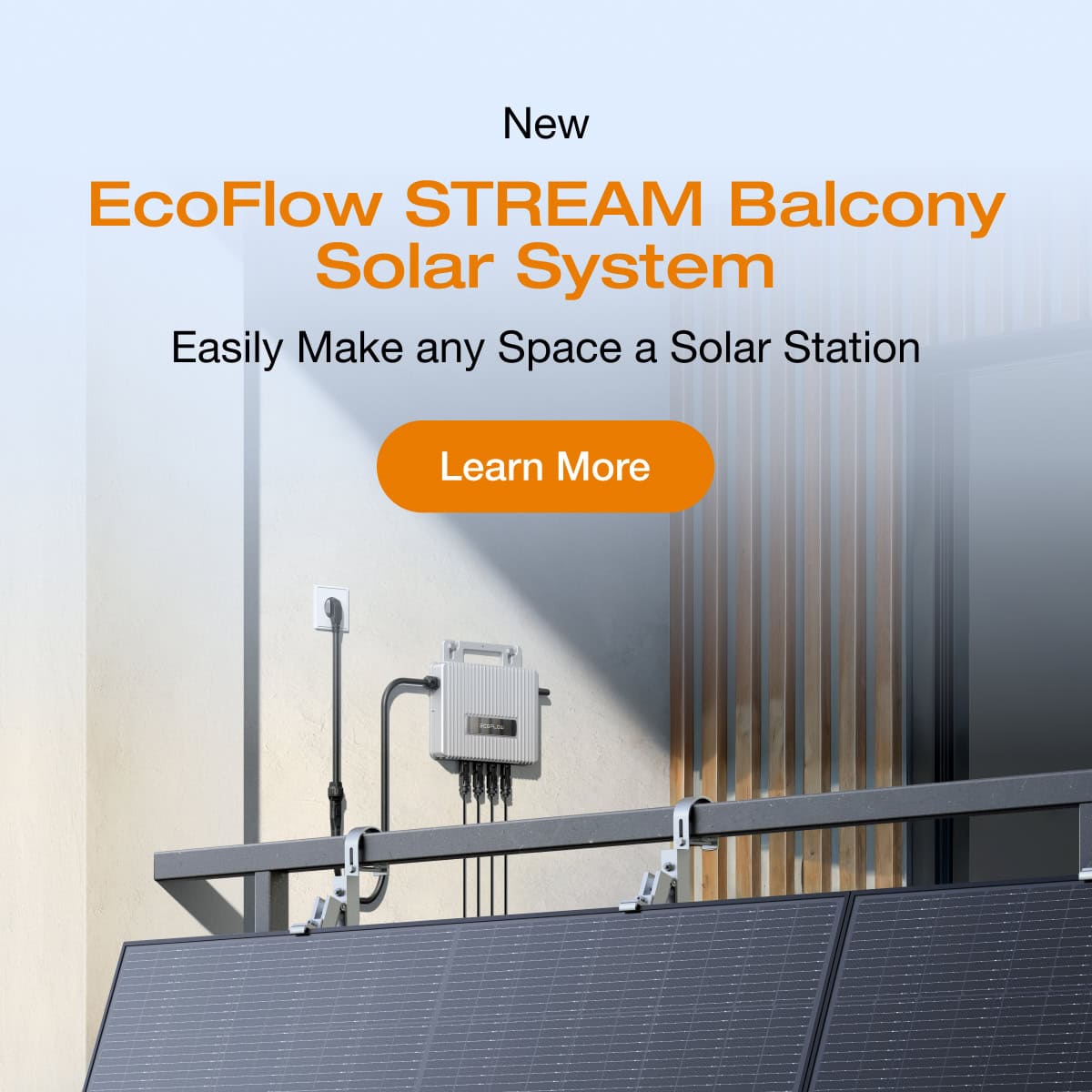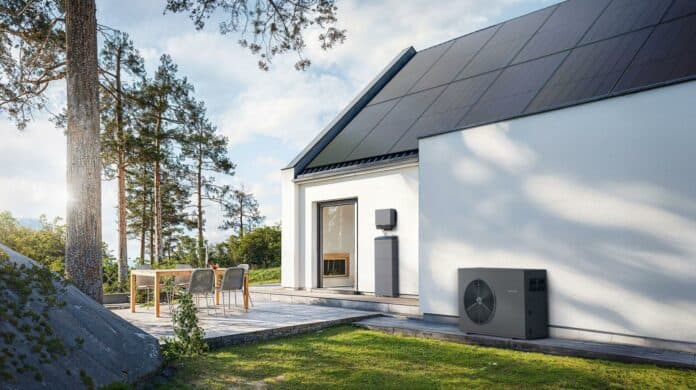Table of Contents
Thanks to rapidly improving technology and falling prices, consumer adoption of solar panels and photovoltaic (PV) systems has exploded in the last decade.
There’s never been a better time to switch to clean, renewable solar energy to power your home or off-grid adventures.
However, calculating how much electricity a PV module or solar panel array can generate over time remains a challenge.
There are many factors to take into consideration, including your location and the type of solar panels you purchase.
Read on and learn how to estimate how much energy a solar panel can produce.
Types of Solar Panels
All solar panel systems that generate electricity from sunlight do so using the photovoltaic effect.
First demonstrated in 1839, photovoltaic materials — like solar cells — produce a physical phenomenon when exposed to photons from visible light, generating voltage and electrical current.
Solar panels are the most common type of photovoltaic (PV) module used to produce direct current (DC) electricity from clean, renewable solar energy (irradiation).
Together with a solar inverter and other balance of system components, PV modules convert DC to AC (household) electricity to power the utility grid, off-grid adventures, and your home.
Solar cells are the essential component of all PV modules, and there are numerous types…
But crystalline silicon (cSi) is by far the most common material used for manufacturing PV cells.
The different types of solar panels typically take their name from the primary material used in the solar cell (i.e., monocrystalline and polycrystalline silicon) or unique ways in which the cell is constructed (PERC).
Here is a summary of the most commonly used solar panel types today.

(Source: ASES)
Crystalline Silicon
Monocrystalline or polycrystalline silicon is the primary material used in the vast majority of PV modules and solar cells.
According to the International Energy Agency, crystalline silicon (cSi) “remains the dominant technology for PV modules, with a market share of more than 97% estimates.”
Let’s explore the differences between monocrystalline and polycrystalline PV cells.
(Source: ResearchGate)
Monocrystalline Silicon
When it comes to efficiency, monocrystalline solar panels win hands down.
Unlike polycrystalline PV cells made from melted silicon fragments, the solar wafers used to manufacture monocrystalline PV modules are cut from an ingot made from a single crystal of lab-grown silicon.
The purity of the material enables the cells to generate more electricity per square meter from the same amount of sunlight.
Because the manufacturing process requires more energy and raw materials, monocrystalline solar panels are also more expensive to produce.
However, with efficiency ratings as high as 23% vs 13-18% for polycrystalline, electricity bill savings and the reduced surface area required for installation often more than offset the higher upfront cost.
With their distinctive black appearance, monocrystalline solar panels are also more aesthetically pleasing and blend in with any home design or roof.
Polycrystalline Silicon
If solar panel efficiency isn’t a concern, polycrystalline solar panels tend to be cheaper than monocrystalline PV modules.
Polycrystalline silicon PV cells are less expensive and time-consuming to produce.
However, any savings you make on price will likely be outweighed over the long term by inferior performance.
Instead of pure silicon wafers, polycrystalline PV cells are made from the fragments of many silicon crystals fused together by heat.
The waste product from manufacturing is recycled, leading to less wastage than with mono panels.
By eliminating some of the time and materials required to manufacture monocrystalline silicon, poly PV panels come at a lower retail price.
More on monocrystalline vs polycrystalline solar panels.
Passive Emitter and Rear Contact (PERC)
Passive Emitter and Rear Contact (PERC) photovoltaic cells can be monocrystalline or polycrystalline.
The difference between PERC and traditional cSi solar cells isn’t in the type of silicon used.
Rather, it’s the application of a passivation layer of antireflective material (silicon nitride) to the rear surface of the PV cell designed to capture additional sunlight.
Additionally, the rear contact of the cell is “opened” using laser and screenprinting techniques.
In some cases, PERC PV cells can provide greater efficiency than traditional crystalline silicon solar cells.
Al-BSF PV cells use similar technology.
Thin Film (Second Generation Solar Cells)
Not all photovoltaic cells are made from crystalline silicon.
Thin-film solar panels are a newer technology used mostly in large-scale commercial PV systems.
Thin-film PV modules are flexible and inexpensive to produce.
However, they’re highly inefficient (5-12%), making them impractical for residential use.
The most commonly used photovoltaic materials in thin film solar panels are:
- Cadmium Telluride (CdTe)
- Copper Indium Gallium Selenide (CIGS)
- Gallium arsenide (GaAs)
- Amorphous Silicon (a-Si)
Emerging Technology (Third Generation Solar Panels and Cells)
The following photovoltaic cell technologies are in the early stages of development.
It will likely be some years before these types of solar cells are used in PV modules designed for residential use.
If any of these emerging PV technologies prove commercially viable, they’ll first be used to facilitate utility-scale electricity generation, which will aid in the transition away from fossil fuels.
How Much Energy Can a Solar Panel Generate?
Understanding how much power a single PV module or solar panel array requires a basic understanding of how electricity output is measured.
Watts and Watt-Hours
For most consumer applications, electricity production potential from solar panels is measured using two related metrics.
- Watts/Kilowatts: The AC output capacity of a solar panel or balance of system is measured in watts (W) or kilowatts (kW).
For example, EcoFlow’s 400W portable solar panel can output 400 watts maximum of electricity under ideal conditions.
The maximum electricity generation potential of solar panels is called rated power. - Watt-Hours/Kilowatt Hours: You’re probably familiar with watt-hours (Wh) and kilowatt-hours (kWh) from your electricity bill.
Watt-hours measure electricity consumption over time.
For example, an appliance that requires 400W of operating power will consume 400Wh (0.4kWh) per hour for as long as it runs.
It’s essential to have a solid understanding if you’re planning on purchasing an off-grid or hybrid solar power system. Both rely on solar battery storage, and capacity is usually measured in Wh/kWh.
Learn more about calculating kW and kWh requirements.
Starting and Running Watts
Another thing that often gets overlooked when shopping for off-grid or hybrid systems is the difference between starting and running watts.
Many high-wattage home appliances — especially those that rely on motors, like fridges and washer/dryers — require significantly more power to switch on than they do to run.
Here are some examples.
Starting and Running Watts of Typical Household Appliances
| Appliance | Rated (Running) Watts | Starting Watts |
| Dishwasher | 1300 | 1800 |
| Washing Machine | 1200 | 2300 |
| Refrigerator/Freezer | 700 | 2200 |
| Light Bulb | 60-75 | 0 |
| Microwave | 600-1000 | 0 |
| TV | 500 | 0 |
| Toaster | 900 | 0 |
| Vacuum | 1440 | 2500 |
| Coffee Maker | 1000 | 0 |
| Blender | 300 | 800 |
| Clothing Iron | 1500 | 0 |
| Dryer | 5400 | 7000 |
| Toaster Oven | 1200 | 0 |
| Curling Iron | 1500 | 0 |
| Space Heater | 2000 | 0 |
| Laptop | 50-300 | 0 |
| 20” Box Fan | 200 | 350 |
Ensure that the AC output of your portable power station or other balance of system has sufficient starting watts (surge power) to start your appliances, not just run them.
Unfortunately, fossil fuel generators that run on petrol or propane can only provide about 10% surge power above their maximum operating wattage.
An EcoFlow solar generator like DELTA Pro can output double its running wattage (3600W continuous/7200W surge power).
Rated Power
Rated power measures the maximum electricity generation potential of a PV module under Standard Test Conditions conducted in a laboratory.
It’s essential to understand that lab conditions rarely — if ever — exist in the real world.
Standard Test Conditions for Solar Panels
| Condition Type | Standard Test Condition | Real-World Conditions |
| Solar Incident Angle | Always zero, irradiation beam always normal to the PV panel* | Variable, and depends on time, date, and site latitude. In the case of rooftop systems, roof orientation, and inclination govern system capacity. |
| Solar Irradiation | Always equal to 1000 Watts/m²* | Variable and depends on the time, date, and site latitude. Limited sunshine hours bound system capacity. |
| Ambient Temperature | Always 25°C* | Variable and depends on the time, date, weather condition, and site latitude. Higher ambient temperature degrades PV panel efficiency and reduces system output. |
| Air Mass Coefficient (AM) | Always equal to 1.5* | Variable and depends on the time, date, and site latitude. Higher AM with higher latitudes. |
| System Losses (e.g., Wiring, Inverter) | Always Zero* | Variable and depends on the design and location of PV panels, inverter, and grid meter. |
*Cannot be achieved in real-world operation (Source: ResearchGate)
It’s a common misconception that, for example, a 400W rigid solar panel will produce 400W of continuous electricity per hour during the day.
The reality is that while a PV module will never exceed its rated power output, it will frequently generate less electricity, even during daylight hours.
Since rated power and PV module efficiency are determined in a lab, how can you know how much electricity your solar panels will actually generate at your location?
By taking real-world conditions into consideration and making an informed projection.
Here’s how.
What Factors Influence How Much Energy is Produced by Solar Panels?
The most significant hurdle to the mass adoption of all forms of renewable energy has arguably been its unpredictability.
Unlike fossil fuels, the amount of energy you will produce from wind, solar, or geothermal power is impossible to forecast with certainty.
Fortunately, there are many solutions to the problem.
Before getting into those, let’s briefly summarize the challenges and opportunities of solar panel installations.
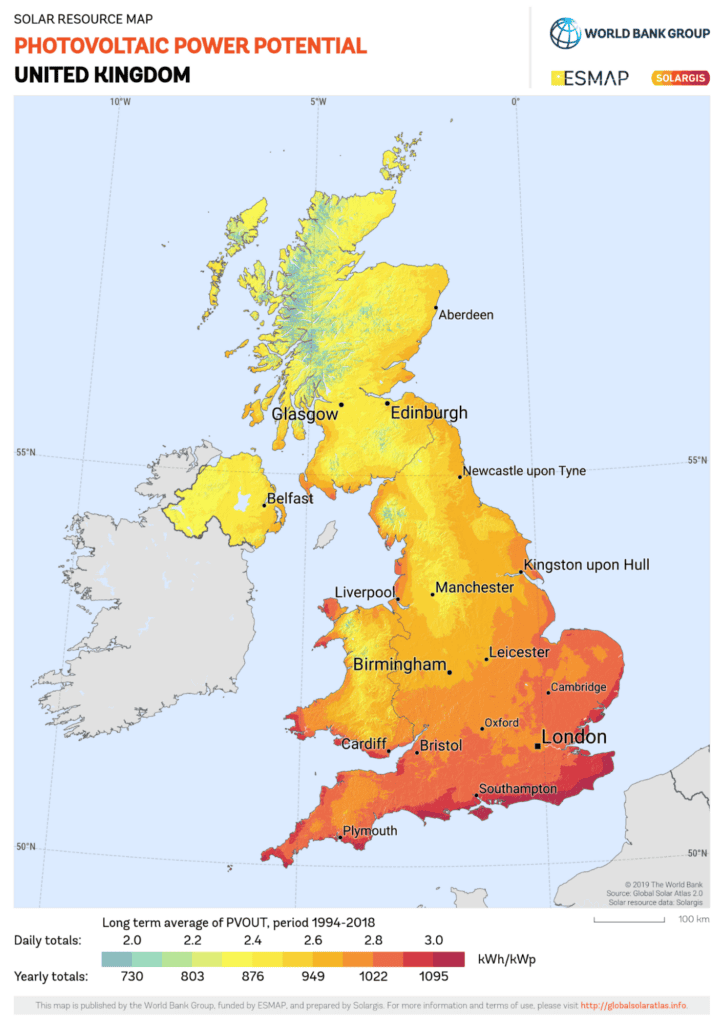
(Source: Global Solar Atlas)
Solar Resource and Potential
Even with all of today’s forecasting technology, it’s impossible to predict with certainty how much electricity any given solar panel array will produce tomorrow.
However, historical records of how much sunlight a location receives have been kept for years and provide an invaluable tool for forecasting solar resources and potential.
The map above shows the estimated photovoltaic power potential for each region in the UK.
As you can see, the south of England receives significantly more peak sunlight on average than the north.
More detailed estimates by location are easy to find.
Once you know how many peak sun hours you can expect in your area, you can begin calculating how much electricity output you should be able to achieve from any given solar panel.
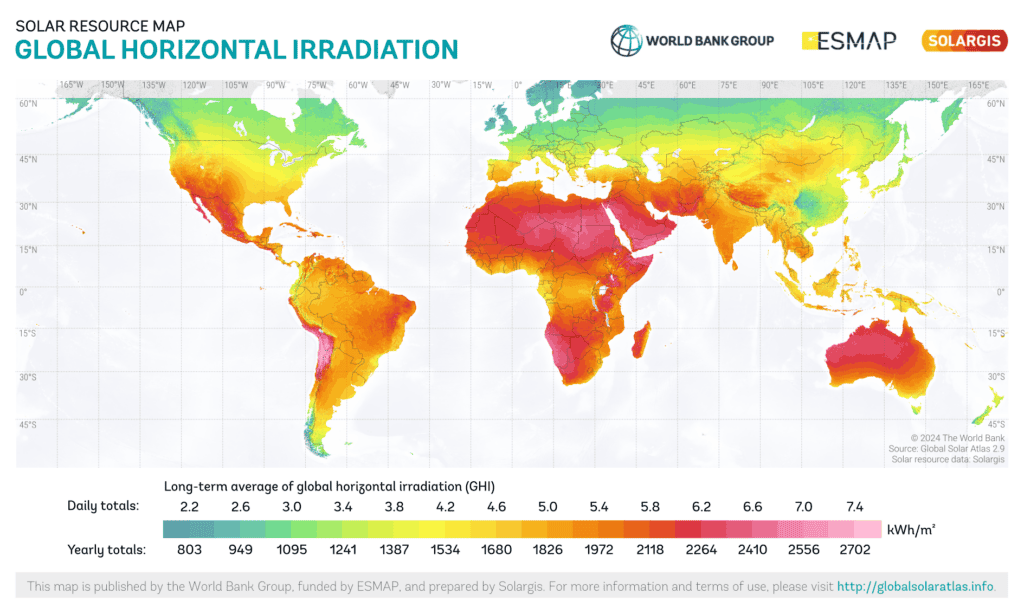
(Source: Global Solar Atlas)
Global Horizontal Irradiance
Global Horizontal Irradiance (GHI) is the scientific term for a measurement that integrates Direct Normal Irradiation (DNI) with Diffuse Horizontal Irradiation (DHI), which is a fancy way of saying it shows the average sunlight by location based on past measurement.
The terms GHI and solar potential are used somewhat interchangeably.
Either one can help forecast the average expected sunlight at your location.
Efficiency
Photovoltaic module ‘efficiency’ is a frequently misunderstood concept.
It does indicate how ‘efficient’ a solar panel is at generating electricity from sunlight but in a very specific way.
Like rated power, solar panel efficiency is determined in a lab under ideal Standard Test Conditions.
In locations that receive abundant sunlight, efficiency can be an overrated metric.
Unlike fossil fuels, which are in finite supply, solar power is a sustainable resource — you never have to worry about running out of petrol.
However, the UK receives relatively little sun compared to other countries, making efficient solar panels a wise investment.
Efficiency measures the electricity generation potential of a PV module receiving 1000 Watts/m² — the equivalent of direct sunlight.
It also assumes a temperature of 25°C and perfect alignment with the horizon.
Investing in high-efficiency solar panels ensures you maximize electricity generation per square meter at your location.
EcoFlow’s industry-leading rigid and portable solar panels offer `23% efficiency, helping to shorten your solar payback period and maximise return on investment.
At first blush, 23% may not seem very high…
But it’s the highest efficiency rating currently on the market.
Intermittency
Renewable energy sources like solar, wind, and hydropower are virtually inexhaustible and essential to transitioning to a net-zero carbon emissions future.
However, all sources of clean, renewable power are intermittent.
The wind doesn’t blow every day, and solar panels don’t work at night.
Residential on-grid PV systems solve the problem of intermittency by auto-switching to utility electricity when electricity consumption exceeds production.
It’s essential to note, however…
Grid-tied solar power systems do not provide electricity during a blackout.
To avoid injury to workers and damage to the grid, all solar panel, inverter, and bidirectional (smart) meter configurations include an automatic switch that shuts down the system for the duration of a power outage.
Hybrid and off-grid PV systems utilise solar + battery storage and provide power during blackouts and extended outages.
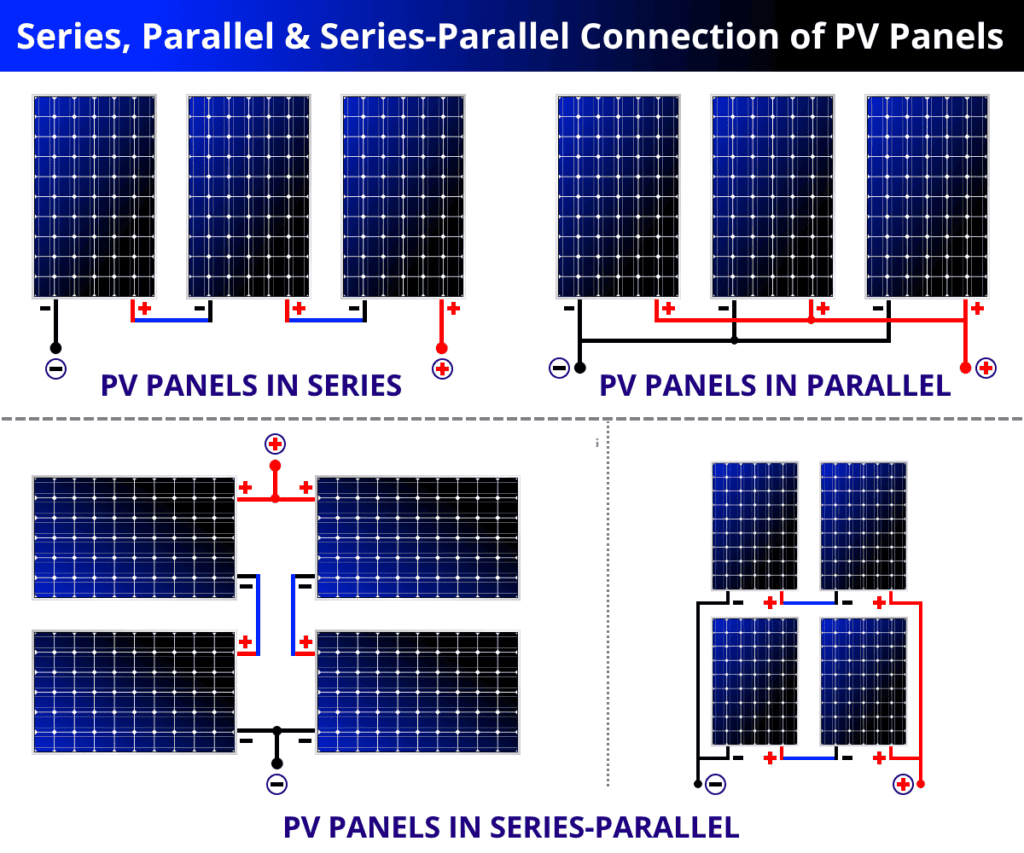
(Source: Electrical Technology)
Series, Parallel or Hybrid?
If you’re installing more than one solar panel, you have a crucial decision to make.
Should you connect the PV modules together in series, parallel or a hybrid of both?
The correct answer depends on numerous factors, including:
- Solar input capacity of your inverter in volts, watts, and amps
- Number of PV panels
- Environmental conditions during the day, especially shade
Connecting solar panels in series increases the combined output voltage of the array, while parallel connections increase the current while voltage remains constant.
In laboratory conditions, the total output wattage of a PV module array won’t increase no matter how you connect the panels.
However, the choice between series and parallel connections can significantly impact performance in the real world.
Learn more about series and parallel connections for solar panels.
Weather Conditions
Solar panels work on cloudy days, but electricity generation is negatively impacted.
Given England’s propensity for rain, investing in high-efficiency monocrystalline solar panels helps ensure you’re making the most of ambient sunlight.
For portable applications, bifacial solar panels are also a solid option.
Monthly Average Daily Sun Hours in the UK 2015 to 2023 (Hours Per Day)

(Source: Statista)
Seasonal Variations
It’s not just cloud cover that you must consider when forecasting solar panel output but also the Earth’s position relative to the Sun over the course of the year.
Shorter days mean less solar irradiance and, consequently, lower electricity generation potential from the same setup than you would receive during the summer months.
Make sure to account for decreased production during the winter months, especially around the solstice when days are shortest.
Temperature
It may surprise you to learn that high temperatures have a negative impact on solar panel efficiency and electricity generation potential.
When it comes to solar power, you can never have too much sunlight, but solar farms in deserts (for example) actually cool PV panels to improve efficiency.
However, the dip in production really only becomes apparent in temperatures over 35° and it rarely gets that hot in the UK (yet).
Angle and Positioning
The optimal positioning for solar panels varies over the course of the day as the Earth orbits the Sun.
Many utility-level PV arrays actually use solar tracking mechanisms to vary the direction, angle, and tilt of panels based on which position receives the most solar radiation depending on where the Sun is on the horizon.
Solar trackers are available at the consumer level. However, they are expensive.
Consider working with a professional installer to optimise solar panel positioning and capture the maximum amount of peak sunlight daily.
Obstruction and Shade
If you’re investing in mountable solar panels, it’s essential to keep them out of the shade during peak sunlight hours as much as possible.
For rooftop installations, check out which parts of your installation area are shaded by trees, buildings or other obstructions during the sunniest hours of the day.
Peak solar irradiance varies by location, but 1 pm is a good place to start in the UK (on one of those rare sunny days).
Age
As with anything else, solar panel performance decreases over time.
The good news is it only dips by about 0.5 – 1% per year.
According to the US National Renewable Energy Lab (NREL), “PV modules typically degrade slowly—often losing less than 1% of their performance per year—making their degradation undetectable…”
Most solar panel arrays operate for 25-30 years before needing to be replaced, outlasting a house’s roof in many instances.
How to Calculate Solar Panel Output
When calculating the projected output of a single photovoltaic module or multi-unit solar panel array, first consider all of the factors above.
It’s better to underestimate your level of electricity production than overestimate it, especially in off-grid applications.
You can always add more solar panels to your array, but only if your balance of system input capacity allows for them.
It’s crucial not to exceed the maximum input capacity of your solar inverter or charge controller, or you can damage the system irreparably.
For example, EcoFlow RIVER 2 Pro allows you to connect 1 x EcoFlow 220W Bifacial Portable Solar Panel that can generate up to 1.8kW daily.
If that’s not enough electricity to meet your needs, consider upgrading to EcoFlow DELTA 2 or DELTA 2 Max, which have significantly more solar input capacity and offer additional charging options.
Solar Panel Output Formula
The formula for calculating solar panel output is as follows:
Output = STC Rated Power (Rated Power in watts under Standard Test Conditions) x Average Daily Sunlight Hours at Your Location x 0.75
By assuming that your PV modules will produce 75% of their rated power during daylight hours, you account for factors that negatively impact your solar panel array’s electricity output in real-world conditions.
Take EcoFlow’s 400W Rigid Solar Panel, for example:
Output = 400W rated power x 5 Average Daily Sun Hours x .75 = 1,500Wh per day
A high-efficiency 400W solar panel will likely produce a minimum of 1,500 watt-hours per day (on average) in the UK.
Due to all the variables, any calculations of actual output will be a working estimate at best.
You may generate MORE electricity per day, but you’re unlikely to produce less, except during extreme weather conditions.
How to Backup Excess Energy with a Solar Storage Battery
Adding solar battery storage to a photovoltaic system is the best way to ensure energy security and keep your home running during a blackout.
Solar batteries are an essential component of off-grid solar panel systems — without them, you wouldn’t have electricity at night when photovoltaic modules have insufficient exposure to light.
Several types of solar battery chemistry currently dominate the market.
Here are the solar battery battery types in ascending order of efficiency and performance.
- Traditional lead-acid
- Sealed lead-acid (SLA) or Valve-regulated lead-acid (VRLA) — frequently marketed as “deep cycle” batteries
- Lithium-ion (Li-ion)
- Lithium nickel manganese cobalt (NCM/NMC)
- Lithium iron phosphate (LFP/LiFePO4)
NMC and LFP batteries are newer subsets of Li-ion chemistry that offer optimal performance for photovoltaic applications.
Both are highly effective, but LiFePO4 solar batteries tend to have a slightly longer cycle life.
LFP batteries also have a significant humanitarian advantage over traditional Li-ion and NCM which rely on cobalt to function.
75% of the world’s cobalt is mined in the Democratic Republic of Congo (DRC) under nightmarish labour conditions.
By eliminating “blood cobalt” from the manufacturing process, LFP solar batteries are a far more ethical choice.
EcoFlow’s current range of solar generators and portable power stations all use industry-leading LFP battery technology and provide 10 years or more of daily use.
Frequently Asked Questions
The rated power of a solar panel in watts represents the maximum level of electricity generation potential as determined in a laboratory under Standard Test Conditions. STCs only exist in a lab and provide specifications based on ideal conditions that seldom occur in the real world. It’s best to estimate that a PV module will produce 75% of its rated power per daily sun hour at your location.
Final Thoughts
Calculating exactly how much electricity a solar panel will produce by the day — or even the hour — is technically impossible.
There are simply too many factors that impact PV module efficiency and electricity output — many of which can’t be forecast accurately.
Don’t let that scare you.
Fossil fuel and grid electricity prices are also highly unpredictable and unlike sustainable solar power, supplies are running out.
Purchasing high-efficiency solar panels is the best way to ensure energy security and power your off-grid adventures.
If you’re concerned about not generating enough power, purchase with expandability in mind.
That way, you have the flexibility to add more panels once you have a clear picture of how much electricity you generate at your location.



